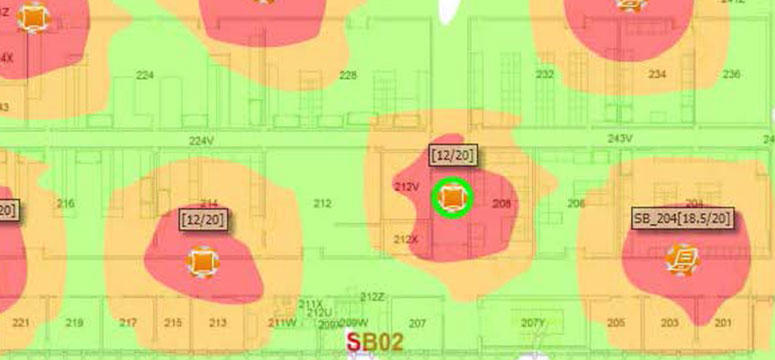April 6, 2015
Wireless network upgrade to boost access and speed across university

Heat maps of the updated second floor of Science B show total wireless coverage.
The University of Calgary’s wireless network is one of the largest and most complex in Alberta, covering what is in effect a small city and four distinct campuses. Making changes to the system is challenging and costly, but in a world where wireless signal can be essential to supporting research, teaching and learning, it’s an investment that pays off.
Now the Information Technology team is putting that investment to good use. Starting in the fall, students, faculty and staff who are working wirelessly across the university will be signing into a significantly upgraded network. New software and infrastructure will improve connectivity, speed and access.
The Network Engineering Team is working throughout the spring and summer on a project more than two years in the making, upgrading the wireless network in nearly every UCalgary building in the city. Building on the work done during last December’s Network Renewal Program, which placed core network services on new infrastructure, the project delivers those improvements directly to users.
Better signals, better speed and more coverage
IT will be focusing its efforts to improve coverage and capacity, working off qualitative surveys and quantitative analysis of heat maps that measured wireless strength throughout the university campuses.
“The heat-mapping technology has really helped us find out where we needed to improve the base infrastructure behind our system — the cables and routers that are the backbone of campus wireless,” says Wolfgang Neumann, manager of Network Engineering. “We will be pulling hundreds of metres of cable in some of these areas and using new access points that will make a major difference for the campus community.”
Most of the physical work will focus on lecture halls and the upper floors of most buildings on all four campuses, as well as a new distributed antenna system to improve cellular coverage in the Foothills campus, whose construction and shielding makes cellular and wireless networking particularly difficult and expensive.
Improving security and usability for guests
Using a new sign-on system that will no longer be dependent on the university’s Central Authentication Service, the wireless network will also allow guest access for the first time, enabling visiting scholars and members of the public to get online without having to request a temporary IT Account.
“In parts of the university where we often have visitors, it’s not uncommon for users to post their IT Account username and password on whiteboards for guests to use,” says Neumann. “Having a guest access system will help improve our overall information security and keep users from developing unsafe workarounds.
“When we started work on this project more than two years ago, we asked our users what their biggest needs were. It’s really great to be able to deliver on all of those needs and to do it in a way that will make a real difference to the entire university.”
